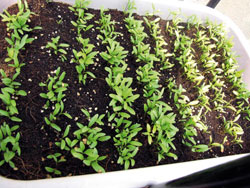Coriander, also known as hara dhania and kothmir in India and Cilantro in the west, is a humble herb that is added to most dishes as a garnish. With its bright green colour and versatile flavour, it is a favourite in every Indian kitchen. This makes coriander a must grow for every home gardener. And there are more reasons why you should be growing it—it is easy to grow, it grows fast, you can get the yields at a very early stage and it keeps yielding. Let’s look at how to grow coriander in a container.
The container
Coriander seeds should be sowed in the container in which you plan to let it grow. This means that if you plant the seeds in a small container or cup, hoping that once they sprout, you will transplant them to a bigger container, then forget it. Coriander does not do well after a transplant. It will simply wilt away and die. So, choose a container that is big enough to start with and will give you a decent amount of coriander harvest.
Make sure the container has drainage holes in it for the water to drain out easily otherwise it will cause rotting of the roots. I usually use trays/tubs to grow them since the soil surface is more in tubs and hence we can grow multiple rows of coriander. Fill the tray with potting mix all the way up to half inch from the top. Then make rows in the soil by drawing a line with your finger or a stick. This makes it easy to sow and also easy at the time of harvesting. The tray is now ready for the seeds to be sowed.
The seeds

Coriander seed is technically a fruit containing two seeds in it. So the round coriander seeds that you probably use in your cooking so often, has two seeds in it. Each of them will grow into a coriander plant. The fruit can be sown whole or split and sown. Splitting increases the germination rate.
So how to go from a whole coriander seed to a split one, without having to split each seed individually? The way I do it is, I wear a slipper in my hand, spread the seeds on the floor [preferably a rough floor], and move the slipper over the seeds while pressing them. This is not the place to show your strength! Remember to be gentle; we are not making coriander powder.
The sowing
Storing tip
To store the coriander leaves for long, wrap them in a newspaper [leaves should not be wet], place them in an airtight container and refrigerate.
Once you have the split seeds, simply sprinkle them over the rows that you had made in the tray. Don’t crowd the seeds too close to each other as the leaves will need space to grow well. You need about 5cm between each plant for the leaves to get good sunlight and not overlap each other too much. Coriander seeds need to be sowed half inch deep in the soil. Once you have sowed the seeds, cover them with coco peat or soil and water them. Coriander seeds start germinating somewhere between 5 – 7 days after sowing. Once they start germinating, keep them in a place that receives good amount of sunlight. They will start growing vigorously and will be ready for use in another 10 days time.
The harvesting
Coriander leaves can be harvested when the plant is at least six inches tall. Take a sharp scissor and cut the leaves and stems. It can be harvested 3 – 4 times. If you notice that your coriander plant has flowered, save the seeds for the next batch of planting or let them fall and germinate on their own. If you regularly remove the matured leaves, it will delay the plant from flowering.
Your efforts have paid off when you harvest the coriander leaves you yourself planted. Now it’s time to experience the joy and excitement of garnishing your dishes with your own home grown kothmir.
This article was also published in the April 2016 issue of Complete Wellbeing.
 Spot an error in this article? A typo maybe? Or an incorrect source? Let us know!
Spot an error in this article? A typo maybe? Or an incorrect source? Let us know!
